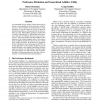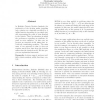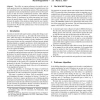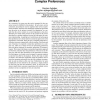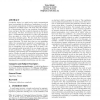AAAI
2006
14 years 3 months ago
2006
People frequently use the world-wide web to find their most preferred item among a large range of options. We call this task preference-based search. The most common tool for pref...
AAAI
2004
14 years 3 months ago
2004
We present an efficient approach to adding soft constraints, in the form of preferences, to Disjunctive Temporal Problems (DTPs) and their subclass Temporal Constraint Satisfactio...
AAAI
2006
14 years 3 months ago
2006
Any automated decision support software must tailor its actions or recommendations to the preferences of different users. Thus it requires some representation of user preferences ...
NIPS
2008
14 years 3 months ago
2008
Young children demonstrate the ability to make inferences about the preferences of other agents based on their choices. However, there exists no overarching account of what childr...
IJCAI
2007
14 years 3 months ago
2007
In this paper we propose a suite of techniques for planning with temporally extended preferences (TEPs). To this end, we propose a method for compiling TEP planning problems into ...
EUSFLAT
2007
14 years 3 months ago
2007
In Multiple Criteria Decision Analysis, the preferences of the decision maker regarding each criterion are classically modelled by a utility function depending on one single varia...
ECAI
2008
Springer
14 years 3 months ago
2008
Springer
The ability to express preferences for specific tasks in multi-agent auctions is an important element for potential users who are considering to use such auctioning systems. This p...
CP
2008
Springer
14 years 3 months ago
2008
Springer
Fuzzy constraints are a popular approach to handle preferences and over-constrained problems in scenarios where one needs to be cautious, such as in medical or space applications. ...
ATAL
2008
Springer
14 years 3 months ago
2008
Springer
In e-commerce, for some cases the service requested by the consumer cannot be fulfilled by the producer. In such cases, service consumers and producers need to negotiate their ser...
ATAL
2008
Springer
14 years 3 months ago
2008
Springer
Complexity theory is a useful tool to study computational issues surrounding the elicitation of preferences, as well as the strategic manipulation of elections aggregating togethe...

